The Best Polarized Lens Tints For Sailing. According To The Best Sailors.
Leading polarized lens maker Tajima-Direct.com, speaks to Pete Burling, Steve Benjamin, Ken Read, Dave Hughes, Brian Porter and Cam Lewis about their favorite polarized lens tints and technologies.
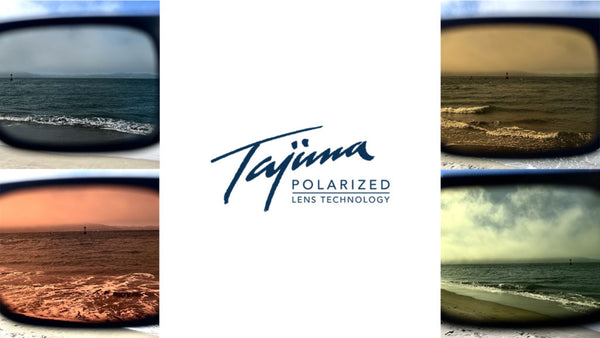
All polarized lenses are not created equal. Nor are sunglass and prescription lens technologies. Like any product on the market, once you know the facts, educate yourself, seek expert advice, you’ll be informed to make the best decision for you. After all, everyone is different…just as weather changes and bodies of water vary, lens tints are a matter of what works best for you. Long time polarized lens developer and Tajima Direct co-founder Steve Rosenberg, a former champion sailor himself, speaks with some of the very best sailors in the world about their lens tint and technology preferences.
America’s Cup champion and Olympic Gold Medalist Pete Burling doesn’t want his polarized lenses too dark. Olympic Silver Medalist and multiple world champion Steve Benjamin wants his lenses dark in bright conditions, yet also likes options. Olympian Dave Hughes prefers a Gray tint with a Blue Mirror for his go-to all-purpose pair. While prescription progressive polarized lens wearers, Melges World Champion Brian Porter and off-shore multihull record setter Cam Lewis, prefer a dark Blue Mirror as their go-to everyday prescription lens. World Champion and all-time great Ken Read simply asks the question: “What’s best for me to read puffs?”
Developing polarized lens technology for three decades and working with some of the greatest athletes across the world of sports, including, of course, the best sailors, has taught me a couple things. First, everyone is different, sees things differently, and has different needs and tolerances. Second, some people can handle, and even demand, a lot of information and won’t get overwhelmed by a variety of specific tool selections to get the job done. They like to fine tune their vision for detailed advantages. That’s Steve Benjamin. And he’s good at it. Others, prefer to keep it simple. They know what they like, and when they find it, they tend to be resistant to change until they see something even better. That’s Pete Burling. Both sailors are complex thinkers and problem solvers that know what they want and what they like. Yet Burling and Benj sit at opposite ends of the lens selection spectrum. Then, there’s the rest of us who fall somewhere in the middle.
I’ve had the pleasure of working with Pete Burling since he was 14 years old when his father first reached out seeking quality eye protection for his young star in the making. Pete’s been wearing our Gray polarized lens ever since – half his life – with very few changes along the way. He prefers a lens that is not too dark, in a natural tint that delivers contrast in neutral tones to span a variety of sun conditions. He demands a polarized lens that removes glare off the surface to bring texture and patterns to life with accurate depth perception and a wide unobstructed field of view. He never removes his lenses. He wants hi-quality then keeps it simple so he can put all his energy into racing and does his best to remove and limit distractions.

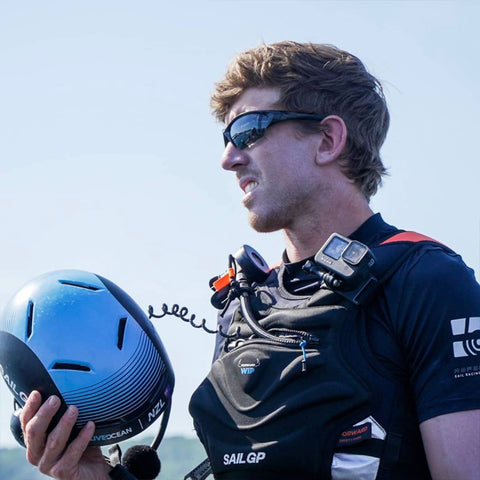
Benj, as many know, is the master of speed development and fine tuning. He’s adept at consuming information and filtering it into good decisions, and he’s not afraid to experiment if it will lead to an advantage. “I prefer wearing the best lenses for a number of reasons. Most importantly, my eyes have always been sensitive to sunlight so I prefer a dark polarized lens most of the time, so I don’t squint and stay as relaxed as possible,” says Benj.
Benjamin continues, “Superior polarized lenses are far better for reading the wind gusts and shifts on the water, so that’s all I wear. I’ve found there’s a big difference between all the various lenses on the market. And I want it all! I want the glare removed that only superior polarized lenses offer. I want the lenses sharp and crisp and I want the right lens tint that’s dark enough in bright conditions but also increases contrast. By combining all of these elements I feel like I’m seeing details and reading the water and shifts without hesitation. I’ve been going between your Tajima Gray with Black Mirror and Gray with Blue Mirror. On cloudy days I tend to prefer your Copper lenses that are dark with added contrast for when changing light goes flat, and in fog there is nothing better than the Yellow Green low light lenses that let in more light, block the irritating bouncing glare on a flat light day that also adds more contrast and breeze reading details.”
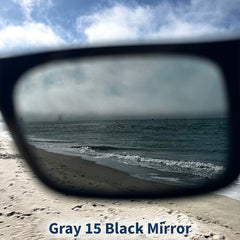
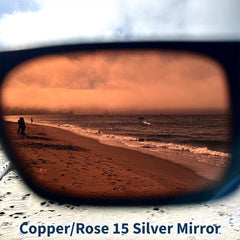
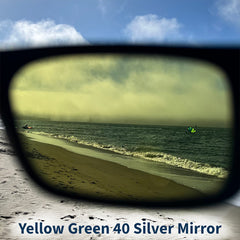
Olympian and world champion tactician Dave Hughes has experimented with various lens tints over the years, but settled on Tajima’s Gray 15 Blue Mirror as his go-to every day, every condition polarized lens. “I’m religious about protecting my eyes. With the number of days I spend on the water year after year, I can’t afford not to be. A crisp and clear lens that can carry me through a range of conditions is the gold standard,” comments Hughes. He continues, “I travel with two types of Tajima lenses – the True View Gray 15 Blue Mirror and the Brown 15 Green Mirror. The Blue Mirrors are my go-to option. They are my no questions asked, no idea what the weather will bring, all-purpose lenses. I pack those in my bag and am confident I’ll be covered. The Brown 15 Green Mirror work really well for me in foggy and low light conditions where I’m looking for heightened contrast and detail in flat light. I find I’ve been rotating in those lenses more and more lately.”
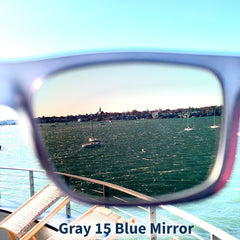
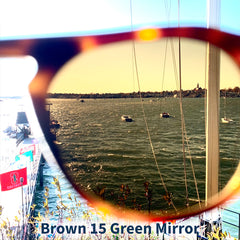
One trend we’ve seen over the past couple years is the sailor who understands that 2 pairs of lens tints can effectively span the light spectrum from bright to flat. As Hughes states above, it seems to be Gray 15 Blue Mirror for bright to changing light, and then Brown 15 Green Mirror for added contrast and detail when the light goes flat or overcast, yet that can also work well in bright conditions. Many sailors prefer the Blue Mirror in brighter ocean conditions, and the Brown Green Mirror for inland, coastal, or brackish water conditions where water color can help identify current or tide lines with more defined color saturation and separation. This color saturation and separation is provided by contrast enhancing polarized lens tints – such as Brown, Copper and Yellow Green.
This trend rings true with former Rolex Sailor of the Year and world champion Brian Porter, who races scows on Lake Geneva, but also travels the world for Melges racing. Porter is a lifelong prescription lens wearer who’s had tremendous difficulty finding Prescription Polarized Progressive lens technology to adapt to his active racing style, while also delivering sharp, accurate world class polarized optics. “I’ve struggled in the past to feel comfortable in progressive lenses racing. I wear them in my daily clear lenses, but it wasn’t until we fully discussed what I wanted racing. You then put me into your top shelf, most accommodating progressive lens design with some slight adjustments to my Seg Height so the reading zones don’t impair or disrupt my eye movement. They were perfect! I don’t have any issues reading my compass, reading my mast instruments, quick looks in the cockpit and of course, sharp, vivid distance vision for reading breeze, wind fields and identifying on-course competitors and fleet dynamics,” said Porter.
When Porter was preparing for the 2022 Melges 24 World Championship, he knew he wanted to carry two pairs of prescription polarized progressive lenses. Not only serving as a backup, but he wanted one pair for bright conditions and one for cloudy or flat light. “I wanted a sharp, yet relatively dark tint lens for the bright sunny days in Lauderdale and a contrast, color saturation lens for overcast, rainy or flat light days. I went with the Gray 15 Blue Mirror for bright days and the Brown 15 Green mirror for flat light. They were just stellar…exactly what I was hoping for! We had bright sun the entire regatta so I ended up running the Blue Mirror every day. But I also took the Brown Green Mirror lenses out each day as a back-up and if the light did go flat, the Brown Green Mirror really seems to knock down glare and bring texture and details to life,” he said.
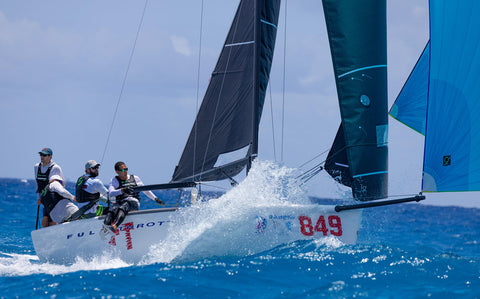
As one of the world’s greatest all-around sailors of the past four decades, Cam Lewis is a multiple world champion, offshore world record holder, and one of the most sought after multihull offshore experts in the sport with countless oceans crossed and circumnavigations. All this abuse from harsh elements has forced Cam to take care of his eyes as his vision has changed and requires him to wear prescription progressive lenses. His power is strong enough now that most wrapped sunglasses won’t accommodate Cam’s power correction. Tajima Direct has pioneered a new technology solution called “Digital Edge Thinning” that allows edge thickness and overall lens weight to be reduced and effectively focus his corrected distance and near vision through the lens’s sweet spot. Accurate and precise, this technology allows for maximum protection of a wrapped frame, and corrected vision with little noticeable compromise.
With both Lewis and Porter, they require prescription progressive lenses but don’t want to give up sailing athletic boats. They sourced expert advice in the field and asked Tajima Direct to customize prescription lens solutions to their specific needs. They both favor Tajima’s Gray Blue Mirror as their primary go to lens. Cam also favors Gray Black Mirror for a more subtle cosmetic finish. He’s found the Gray lens tint to be the most comfortable for him while rendering natural colors, neutral tones, and sharp details across the spectrum of sun conditions.
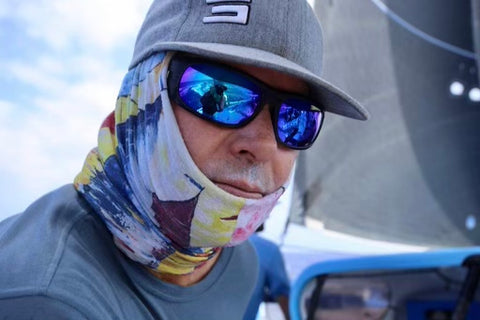
Then there’s one of America’s greatest sailors, Ken Read. He simply emailed and asked, “what’s the best lens tint for me to read puffs?” That simple question received this simple response …er, rhetorical question back: “What do you like? Do you prefer a natural tint or contrast enhancing? Darker, or lighter?” Read came back and said, “I want an all-around tint that will allow me to read wind in a variety of conditions and light tint for rain and overcast.”
Kenny initially settled on Tajima’s Gray 15 Black Mirror – to deliver that all-around lens that also provided Read with a subtle cosmetic mirrored finish. He also went forward with Tajima’s specialized low light Yellow Green 40 for dawn and dusk, cloudy and rainy days to brighten up and better present texture and details. Important for low light conditions and those flat light days when glare is still high, but normal dark tint lenses may be too dark for some.


Selecting the right lens tint for you shouldn’t be complicated. Don’t overthink it and don’t let it overwhelm you. Consider what you like and makes you comfortable. Take cues from these great sailors above…as Burling likes to do, Keep it Simple. Especially if you’re unsure, Gray is an easy and good choice as it’s a neutral and natural lens tint while still providing great color and contrast. One Tajima Polarized lens tint in Gray, Brown or Copper will easily perform visually and take you through the variety of light and water conditions you’ll encounter. For those that like to specialize, consider one dark tint for bright sun and one contrast tint for low / flat light days. Most common – Gray and Brown. Both will work in bright and flat light. If you like to specialize, consider Steve Benjamin’s path – Blue Mirror for bright sun, Copper for variable conditions, and Yellow Green for low light, fog or rain.
For more, Read the full interviews with:
To get Tajima polarized lenses in your favorite frames: